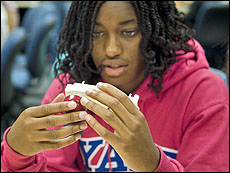Archives
Virtual coasters are goal of workshop for girls
By ELLEN GOLDBAUM
Contributing Editor
Instead of visiting an amusement park this summer and riding on roller coasters, 16 high school girls attending a UB engineering workshop are developing their own virtual roller coasters—and they'll get to "ride" them, too.

Adele Jackson-Gibson is one of 16
high school girls attending a workshop designed to acquaint them with
the rapidly changing field of engineering design.
PHOTO: DOUGLAS
LEVERE
Based in UB's New York State Center for Engineering Design and Industrial Innovation (NYSCEDII), the 2007 Fisher-Price Cyber-Engineering Workshop for Young Women began July 30 and will run through tomorrow.
The workshop is designed to engage high school girls in the use of engineering techniques, such as computer graphics, motion control and virtual prototyping, to demonstrate the exciting and rapidly changing field of engineering design.
"The U.S. is not producing enough engineers to supply our needs for the future," says Kenneth W. English, NYSCEDII deputy director. "One thing that receives a lot of attention is, 'How do we attract more women to the field?' So we decided to do our workshop this year for young women."
In keeping with that philosophy, he says, the workshop coordinators decided to grant admission to all applicants on a first-come, first-serve basis.
The two-week workshop is focusing on teaching students the skills they need to develop their virtual roller coasters, including energy concepts, simulations for engineering analysis, product modeling using computer-assisted design, physics and motion simulation, and the development of track geometries for roller coasters.
Teams of students are creating their own ride simulations with computer programs that control the movements of the NYSCEDII motion platform, a spatial motion base in the center's immersive visualization lab.
While the platform is moving, a 10-foot-by-8-foot display shows visualizations that simulate the "ride" that motion base passengers are experiencing.
Tomorrow, on the last day of the workshop, the girls and their families will have an opportunity to "ride" virtual roller coasters in the NYSCEDII lab.
"Fisher-Price is happy to play a role in helping expose and encourage women to explore the sciences," says Jim Meade, a principal engineer in Fisher-Price's Electrical Engineering Division and a workshop coordinator.
"As one of the larger corporations in Western New York, we believe that it's the responsibility of a corporation like Fisher-Price to be supportive of creative initiatives like this, especially at the university. Ultimately, we do hire a lot of University at Buffalo graduates," said Meade, adding that, like himself, 95 percent of the company's electrical engineers at its headquarters in East Aurora are UB graduates.
On Monday, students engaged in a product "rip-down" of a Fisher-Price Shake 'n Go racer, where they discovered how the product works by taking it apart.
The workshop curriculum was developed by English and Kevin Hulme, NYSCEDII research associate, and Julia Goodwin, an engineering technology teacher from the Lewiston-Porter School District. In addition, seven engineers from different Fisher-Price divisions are attending workshop classes to provide additional instruction and support.
Women engineers from area companies such as National Fuel and Rich Products, and from UB are attending lunches with the students to share their experiences and answer questions about career choices.
The idea for the NYSCEDII high school workshop was conceived and implemented by English, Hulme and Kemper Lewis, executive director of NYSCEDII and professor of mechanical and aerospace engineering in the School of Engineering and Applied Sciences.
Sixteen young women who will be entering grades 10-12 in the fall at Akron Central, Clarence, Kenmore East, Lockport, Nichols, Orchard Park and Starpoint high schools are participating.
NYSCEDII was established in 2000 with support from the New York State Assembly and the New York State Office of Science, Technology and Academic Research to provide state-of-the-art techniques and expertise to help New York State industry become more competitive. The center provides basic research, education and training, and industrial outreach in immersive and high-end visualization; rapid virtual prototyping; Internet-based systems for design, computer-assisted design graphics and three-dimensional modeling; real-time interactions with design and analysis simulations; visual interaction with high performance computing applications, and sensory and haptic (touch and feel) tools and interactions with virtual simulations. For more information, click here .
